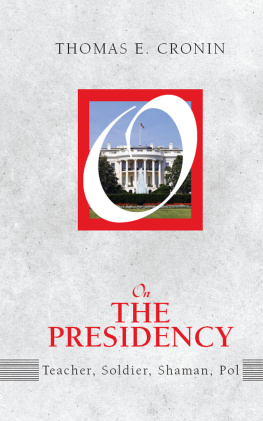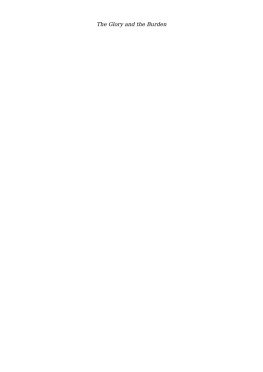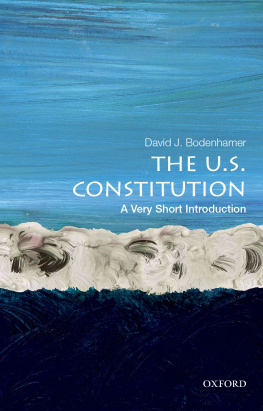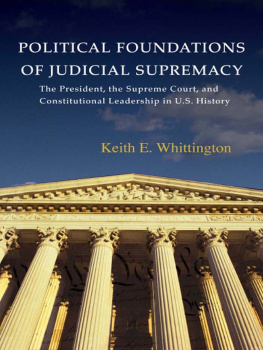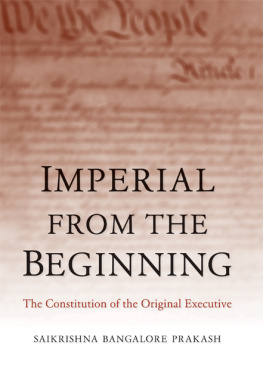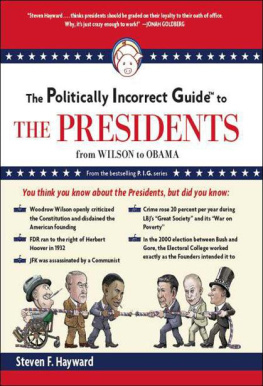The Presidents and the Constitution
The Presidents and the Constitution
Volume 1
From the Founding Fathers to the Progressive Era
Edited by Ken Gormley
NEW YORK UNIVERSITY PRESS
New York
NEW YORK UNIVERSITY PRESS
New York www.nyupress.org
2020 by New York University
All rights reserved
Originally published as part of The Presidents and the Constitution, edited by Ken Gormley, 2016 by New York University.
References to Internet websites (URLs) were accurate at the time of writing. Neither the author nor New York University Press is responsible for URLs that may have expired or changed since the manuscript was prepared.
Library of Congress Cataloging-in-Publication Data
Names: Gormley, Ken, editor.
Title: The presidents and the constitution / edited by Ken Gormley.
Description: New York : New York University Press, 2020. | Includes bibliographical references and index. | Contents: Volume I. From the Founding Fathers to the Progressive Era.
Identifiers: LCCN 2019041459 | ISBN 9781479802067 (cloth) | ISBN 9781479802128 (paperback) | ISBN 9781479802098 (ebook) | ISBN 9781479802050 (ebook)
Subjects: LCSH: Constitutional historyUnited States. | PresidentsLegal status, laws, etc.United States. | Executive powerUnited States.
Classification: LCC KF4541 .P74 2020 | DDC 342.73/06dc23
LC record available at https://lccn.loc.gov/2019041459New York University Press books are printed on acid-free paper, and their binding materials are chosen for strength and durability. We strive to use environmentally responsible suppliers and materials to the greatest extent possible in publishing our books.
Manufactured in the United States of America 10 9 8 7 6 5 4 3 2 1
Also available as an ebook
This book is dedicated to the law students, graduate students, and undergraduates at the authors respective universities and colleges whose interest in, and enthusiasm for, the topic of American presidents and the Constitution has inspired the telling of this important story. The editor additionally dedicates this book to his wife, Laura Kozler Gormley, their childrenCarolyn, Luke, Becca, and Maddyand their two puppies, Gracie and Simba, who endured years worth of boxes piled up in the study, along with nights and weekends listening to nonstop stories about obscure presidents, as the book took shape. It may not be the same as serving as president of the United States, but being cochief executive of this wonderful familyalbeit with limited powers, in a much smaller white house in Pittsburghis the greatest honor imaginable.
Ken Gormley
Pittsburgh, Pennsylvania
Contents
Ken Gormley
Richard J. Ellis
Louis Fisher
Cliff Sloan, Louis Fisher, and Moshe Spinowitz
Ralph Ketcham
Gary Hart
Jonathan L. Entin
Mark A. Graber
Michael J. Gerhardt
David Marks Shribman
Robert J. Spitzer
Frank J. Williams
Paul Finkelman
Joseph F. Rishel
Paul Finkelman
Thomas A. Horrocks
William D. Pederson
Michael Les Benedict
John F. Marszalek
Michael A. Ross
Thomas C. Sutton
Thomas C. Sutton
Donald Grier Stephenson Jr.
Allan B. Spetter
24. Grover Cleveland, Second Term
Donald Grier Stephenson Jr.
Thomas C. Sutton
William D. Bader
Francine Sanders Romero
Ken Gormley
An Unfinished Presidency
Ken Gormley
The presidency of the United States is the most powerful position in the American system of government, and perhaps in the world. As Woodrow Wilson once wrote, the chief executive is the vital place of action in the system, whether he accepts it as such or not, and the office is the measure of the manof his wisdom as well as his force. Yet the Constitution dedicates surprisingly little space to defining the duties or powers of the president; instead, it leaves the contours of that high office to be sketched out in real time, as history plays itself out over distinctive eras in American life.
Article II of the Constitution, which barely contains a thousand words, is the provision in which most of the power of the American presidency is housed. In one sense, the article is vast and awesome in scope. After all, in the period following the Revolutionary War, the framers created a new model of a chief executivea model that had no precise parallel in world history. The office of presidency was designed to maximize the goodand temper the badcharacteristics of executive power known to the framers in the 1780s. This constitutional office thus helped to create a shining new form of republican government and a bold invention in the history of democracy. In this sense, Article II of the Constitution represents one of the great triumphs of American ingenuity. As two prominent presidential scholars have noted: The president would not be a king or sovereign. Instead, he would swear to protect and defend a higher authority: the Constitution.
At the same time, if the framers knew they were creating a revolutionary type of chief executive who would play a central role in the life of the nation, they put surprisingly little meat on the bones of this key figure. Article II, Section 1, vests the executive Power in the president, but does nothing to define the powers that lie at the heart of the chief executives office. Section 2 states that the president shall be Commander in Chief of the Army and Navy, yet it does nothing to clarify the presidents authority in commanding the military. Nor does it untangle the presidents authority from Congresss separate power to declare War (Article I, Section 8, Clause 11), leaving that sticky wicket for another day. Article II, Section 2, empowers the president with the Advice and Consent of the Senate to make treaties, to appoint federal judges, ambassadors, and certain inferior Officers, and to seek advice from principal Officers in the executive branch. The language is ostensibly packed with power, yet it is surrounded by a mist of uncertainty: If the president must secure the advice and consent of the Senate to appoint certain officials, must he or she also obtain permission from the Senate to remove these officials? What about inferior officers in the executive branchhow much control does the president have over these figures if Congress is empowered (as is often the case) to create them in the first place? And if the president plays a central role in appointing ambassadors and making treaties with foreign nations, does this mean that under the Constitution, the president is the chief actor in foreign affairs, more generally?
Even in areas where the presidents powers seem to be clearest, gaps and instances of constitutional silence abound: For example, the Constitution gives the president a seemingly sweeping power to grant Reprieves and Pardons for all federal offenses (Article II, Section 2). Another provision gives the president authority to deliver a State of the Union address to Congress so that he or she can propose legislation (Article II, Section 3). Interestingly, one of the presidents most potent powersto veto legislation that he or she finds objectionable (Article I, Section 7)is wedged into the Constitutions opening article rather than with the other key presidential powers in Article II. Taken together, these provisions seem to crown the president with extraordinary power vis--vis Congress. Yet the Constitution is silent as to when, and for what reasons, the president can trump Congress where there is overlap in authoritywhich occurs frequently. It is almost as if the Constitution assumes that the president and Congress will have to duke it out, battling over the parameters of their respective powers.




